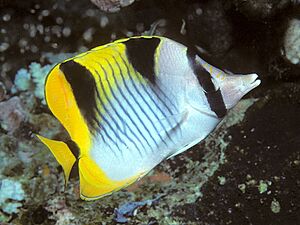Blackwedged butterflyfish facts for kids
Quick facts for kids Blackwedged butterflyfish |
|
|---|---|
 |
|
| Conservation status | |
| Scientific classification | |
| Genus: |
Chaetodon
|
| Species: |
falcula
|
| Synonyms | |
|
|
The blackwedged butterflyfish (Chaetodon falcula), also known as the falcula butterflyfish, is a type of colorful butterflyfish. It's a marine fish, meaning it lives in the ocean. This beautiful fish belongs to the Chaetodontidae family. You can find it swimming in the Indian Ocean.
Contents
What Does It Look Like?
The blackwedged butterflyfish has a white body. It has several thin, dark grey lines going up and down its body. You'll notice two clear black, saddle-shaped spots on its upper back. It also has a black stripe over its eye. The part of its body near the tail, called the caudal peduncle, is also black.
Its fins are bright yellow. This includes the dorsal fin (on its back), the anal fin (on its belly), and the caudal fin (its tail fin). The yellow color also spreads a little onto its body, near the dorsal and anal fins.
This fish has 12 to 13 spines in its dorsal fin. It also has 23 to 25 soft rays. The anal fin has 3 spines and 20 to 21 soft rays. The blackwedged butterflyfish can grow up to about 20 centimeters (about 8 inches) long.
Where Does It Live?
The blackwedged butterflyfish lives in the Indian Ocean. You can find it along the coast of East Africa, from Kenya down to South Africa. It also lives around Madagascar and other islands in the western and central Indian Ocean.
Further east, it's found near Sri Lanka and southern India. This includes the Andaman and Nicobar Islands. You can also spot it from western Thailand all the way to Java. It even lives in the waters around the Cocos (Keeling) Islands, which are part of Australia.
Home and Habits
You can find the blackwedged butterflyfish in water that is 1 to 15 meters (about 3 to 49 feet) deep. They usually live near the edge of coral reefs or on the upper slopes of the reef. They prefer places with strong water currents.
Younger fish, called juveniles, like to hide among the corals. Adult blackwedged butterflyfish are often seen in pairs. Sometimes, you might see them in small groups of up to 20 fish.
What Do They Eat?
These fish are not picky eaters! Their diet includes many small sea creatures. They eat polyps (the tiny animals that make up corals), worms, sea anemones, and crustaceans like small crabs. They also munch on sponges and the feet of sea urchins. They eat other small invertebrates too.
How Do They Reproduce?
When it's time to breed, blackwedged butterflyfish form distinct pairs. They release their eggs into the open water. These eggs float freely in the ocean before hatching.
About Its Name
The blackwedged butterflyfish was first officially described in 1795. This was done by a German doctor and naturalist named Marcus Elieser Bloch. He found the first fish in Tharangambadi, India.
The name falcula comes from a Latin word. It's a smaller version of falx or falcis, which means "sickle" or "scythe." This name refers to the black, wedge-shaped spots on its back. Bloch thought these spots looked like sickles in his original drawings.
This fish is closely related to the Pacific double-saddle butterflyfish (C. ulietensis). Both of these fish belong to a larger group called Rabdophorus. Other relatives include the lined butterflyfish (C. lineolatus) and the spot-naped butterflyfish (C. oxycephalus).


